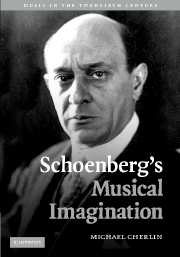Book contents
- Frontmatter
- Contents
- List of music examples and figures
- Acknowledgements
- Introduction
- 1 A passing of worlds: Gurrelieder as Schoenberg's reluctant farewell to the nineteenth century
- 2 Dialectical opposition in Schoenberg's music and thought
- 3 Dramatic conflict in Pelleas und Melisande
- 4 Motive and memory in Schoenberg's First String Quartet
- 5 Uncanny expressions of time in the music of Arnold Schoenberg
- 6 The tone row as the source of dramatic conflict in Moses und Aron
- 7 The String Trio: metaleptic Schoenberg
- Notes
- Bibliography
- General index – names and topics
- Index of Schoenberg's works and writings
5 - Uncanny expressions of time in the music of Arnold Schoenberg
Published online by Cambridge University Press: 22 September 2009
- Frontmatter
- Contents
- List of music examples and figures
- Acknowledgements
- Introduction
- 1 A passing of worlds: Gurrelieder as Schoenberg's reluctant farewell to the nineteenth century
- 2 Dialectical opposition in Schoenberg's music and thought
- 3 Dramatic conflict in Pelleas und Melisande
- 4 Motive and memory in Schoenberg's First String Quartet
- 5 Uncanny expressions of time in the music of Arnold Schoenberg
- 6 The tone row as the source of dramatic conflict in Moses und Aron
- 7 The String Trio: metaleptic Schoenberg
- Notes
- Bibliography
- General index – names and topics
- Index of Schoenberg's works and writings
Summary
the clock ticked on and on, happy about being apprenticed to eternity …
John Ashbery: “Wakefulness”Die Uhren stimmen nicht überein [The clocks are not in unison]
from the Diaries of Franz KafkaIntroduction
Schoenberg's generation inherits its fascination with things uncanny from the Romantics. One need not look far to find examples in German literature from the nineteenth century: the poetry of Goethe, Hölderlin, and Heine, and the prose of E. T. A. Hoffmann and the Grimm brothers provide the most conspicuous and celebrated examples, as do August Schlegel's German translations of Shakespeare (Hamlet, Macbeth, A Midsummer Night's Dream, and The Tempest all feed into Romantic visions of the uncanny). Within Schoenberg's generation, Freud becomes the supreme analyst of the uncanny, while Kafka invents its most profound examples, so much so that his name becomes synonymous with the uncanny. Schubert and Wagner must top the list of musical precursors to Schoenberg's depictions of things uncanny, but examples also can be found in Mozart, Don Giovanni in particular, Beethoven, and others.
The principal focus of this chapter will be on one particular development of Schoenberg's rhythmic practice. It involves the use of a steady pulse-stream, set in contrast to its immediate musical environment, and expressing a sense of altered, “uncanny” time. The practice has antecedents in Schoenberg's tonal music, in Wagner before him, and even earlier, in the music of Schubert.
- Type
- Chapter
- Information
- Schoenberg's Musical Imagination , pp. 173 - 229Publisher: Cambridge University PressPrint publication year: 2007

